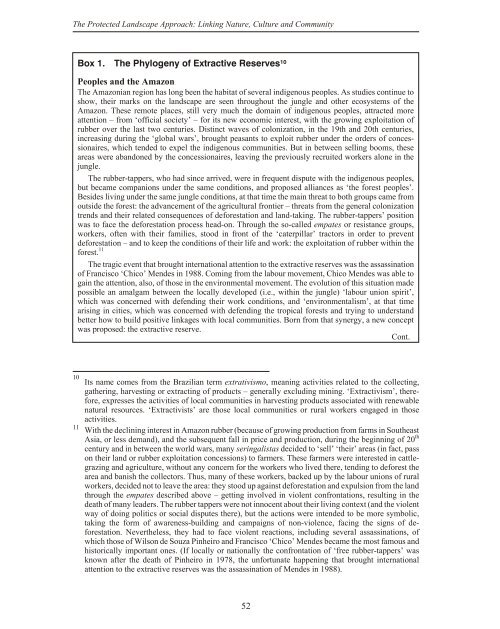The Protected Landscape Approach - Centre for Mediterranean ...
The Protected Landscape Approach - Centre for Mediterranean ...
The Protected Landscape Approach - Centre for Mediterranean ...
You also want an ePaper? Increase the reach of your titles
YUMPU automatically turns print PDFs into web optimized ePapers that Google loves.
<strong>The</strong> <strong>Protected</strong> <strong>Landscape</strong> <strong>Approach</strong>: Linking Nature, Culture and Community<br />
Box 1. <strong>The</strong> Phylogeny of Extractive Reserves 10<br />
Peoples and the Amazon<br />
<strong>The</strong> Amazonian region has long been the habitat of several indigenous peoples. As studies continue to<br />
show, their marks on the landscape are seen throughout the jungle and other ecosystems of the<br />
Amazon. <strong>The</strong>se remote places, still very much the domain of indigenous peoples, attracted more<br />
attention – from ‘official society’ – <strong>for</strong> its new economic interest, with the growing exploitation of<br />
rubber over the last two centuries. Distinct waves of colonization, in the 19th and 20th centuries,<br />
increasing during the ‘global wars’, brought peasants to exploit rubber under the orders of conces -<br />
sionaires, which tended to expel the indigenous communities. But in between selling booms, these<br />
areas were abandoned by the concessionaires, leaving the previously recruited workers alone in the<br />
jungle.<br />
<strong>The</strong> rubber-tappers, who had since arrived, were in frequent dispute with the indigenous peoples,<br />
but became companions under the same conditions, and proposed alliances as ‘the <strong>for</strong>est peoples’.<br />
Besides living under the same jungle conditions, at that time the main threat to both groups came from<br />
outside the <strong>for</strong>est: the advancement of the agricultural frontier – threats from the general colonization<br />
trends and their related consequences of de<strong>for</strong>estation and land-taking. <strong>The</strong> rubber-tappers’ position<br />
was to face the de<strong>for</strong>estation process head-on. Through the so-called empates or resistance groups,<br />
workers, often with their families, stood in front of the ‘caterpillar’ tractors in order to prevent<br />
de<strong>for</strong>estation – and to keep the conditions of their life and work: the exploitation of rubber within the<br />
<strong>for</strong>est. 11<br />
<strong>The</strong> tragic event that brought international attention to the extractive reserves was the assas sination<br />
of Francisco ‘Chico’ Mendes in 1988. Coming from the labour movement, Chico Mendes was able to<br />
gain the attention, also, of those in the environmental movement. <strong>The</strong> evolution of this situation made<br />
possible an amalgam between the locally developed (i.e., within the jungle) ‘labour union spirit’,<br />
which was concerned with defending their work conditions, and ‘environmentalism’, at that time<br />
arising in cities, which was concerned with defending the tropical <strong>for</strong>ests and trying to understand<br />
better how to build positive linkages with local communities. Born from that synergy, a new concept<br />
was proposed: the extractive reserve.<br />
Cont.<br />
10 Its name comes from the Brazilian term extrativismo, meaning activities related to the collecting,<br />
gathering, harvesting or extracting of products – generally excluding mining. ‘Extractivism’, there -<br />
<strong>for</strong>e, expresses the activities of local communities in harvesting products associated with renewable<br />
natural resources. ‘Extractivists’ are those local communities or rural workers engaged in those<br />
activities.<br />
11 With the declining interest in Amazon rubber (because of growing production from farms in Southeast<br />
Asia, or less demand), and the subsequent fall in price and production, during the beginning of 20 th<br />
century and in between the world wars, many seringalistas decided to ‘sell’ ‘their’ areas (in fact, pass<br />
on their land or rubber exploitation concessions) to farmers. <strong>The</strong>se farmers were interested in cattlegrazing<br />
and agriculture, without any concern <strong>for</strong> the workers who lived there, tending to de<strong>for</strong>est the<br />
area and banish the collectors. Thus, many of these workers, backed up by the labour unions of rural<br />
workers, decided not to leave the area: they stood up against de<strong>for</strong>estation and expulsion from the land<br />
through the empates described above – getting involved in violent confrontations, resulting in the<br />
death of many leaders. <strong>The</strong> rubber tappers were not innocent about their living context (and the violent<br />
way of doing politics or social disputes there), but the actions were intended to be more symbolic,<br />
taking the <strong>for</strong>m of awareness-building and campaigns of non-violence, facing the signs of de -<br />
<strong>for</strong>estation. Never theless, they had to face violent reactions, including several assas sinations, of<br />
which those of Wilson de Souza Pinheiro and Francisco ‘Chico’ Mendes became the most famous and<br />
historically important ones. (If locally or nationally the confrontation of ‘free rubber-tappers’ was<br />
known after the death of Pinheiro in 1978, the un<strong>for</strong>tunate happening that brought international<br />
attention to the extractive reserves was the assassination of Mendes in 1988).<br />
52

















